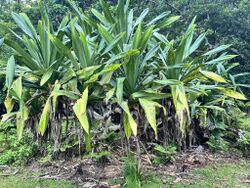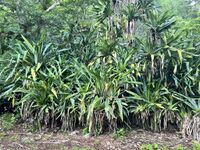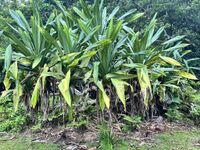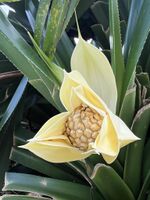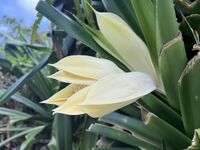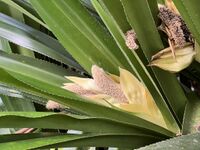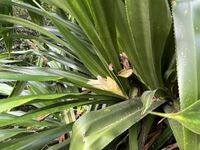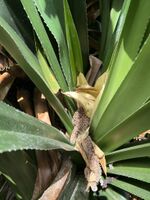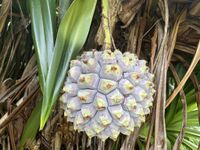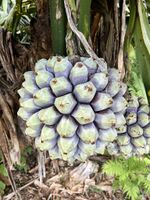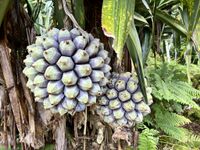Påhong: Difference between revisions
From ChamoruWiki
Jump to navigationJump to search
No edit summary |
No edit summary |
||
| (4 intermediate revisions by the same user not shown) | |||
| Line 1: | Line 1: | ||
{{Infobox plant | {{Infobox plant | ||
| name = | | name = Påhong | ||
| image = | | image = pahong_tree_with_fruit_02.jpg | ||
| image_caption = | | image_caption = Fruit head of ''Pandanus dubius'' | ||
| kingdom = Plantae | | kingdom = Plantae | ||
| clade1 = | | clade1 = Angiosperms | ||
| clade2 = | | clade2 = Monocots | ||
| clade3 = | | clade3 = Commelinids | ||
| order = Pandanales | | order = Pandanales | ||
| family = Pandanaceae | | family = Pandanaceae | ||
| genus = | | genus = Pandanus | ||
| species = | | species = dubius | ||
| binomial = | | binomial = Pandanus dubius | ||
| | | authority = Spreng. | ||
}} | }} | ||
'''Påhong''' | '''Påhong''' (''Pandanus dubius'') s a type of Pandanus tree found along the coastlines and hillsides of the Mariana Islands. Known for its large, rounded fruit head and strong aerial roots, påhong grows in a variety of habitats and is often recognized as a familiar part of the island landscape. While not typically used for weaving, it plays an important role in protecting shorelines and providing shade and food for wildlife. | ||
== Cultural uses == | == Cultural uses == | ||
| Line 43: | Line 33: | ||
* Strongly glaucous and somewhat purplish. | * Strongly glaucous and somewhat purplish. | ||
* Pithy structure with thin endocarp and large seeds, often 15 cm or longer. | * Pithy structure with thin endocarp and large seeds, often 15 cm or longer. | ||
<gallery widths="200" heights="200"> | |||
File:pahong_tree_with_fruit_01.jpg|Påhong tree | |||
File:pahong_tree_with_fruit_02.jpg|Påhong tree | |||
File:pahong_fem_inflorescence_01.jpg|''P. dubius'' female inflorescence | |||
File:pahong_fem_inflorescence_02.jpg|''P. dubius'' female inflorescence | |||
File:pahong_male_inflorescence_01.jpg|''P. dubius'' male inflorescence | |||
File:pahong_male_inflorescence_02.jpg|''P. dubius'' male inflorescence | |||
File:pahong_male_inflorescence_03.jpg|''P. dubius'' male inflorescence | |||
File:pahong_fruit_01.jpg|''P. dubius'' fruit | |||
File:pahong_fruit_02.jpg|''P. dubius'' fruit | |||
File:pahong_fruit_03.jpg|''P. dubius'' fruit | |||
</gallery> | |||
== External links == | == External links == | ||
| Line 50: | Line 54: | ||
== References == | == References == | ||
<references/> | <references/> | ||
[[Category:Pandanus_(genus)]] | |||
[[Category:Plants]] | |||
[[Category:Edible plants]] | |||
Latest revision as of 11:18, 9 May 2025
Påhong (Pandanus dubius) s a type of Pandanus tree found along the coastlines and hillsides of the Mariana Islands. Known for its large, rounded fruit head and strong aerial roots, påhong grows in a variety of habitats and is often recognized as a familiar part of the island landscape. While not typically used for weaving, it plays an important role in protecting shorelines and providing shade and food for wildlife.
Cultural uses
- Seeds are extracted and eaten.
- Whole fruit heads are used as decorations during festivities.
- Leaves are occasionally used for coarse mats but not preferred.
Botanical notes
The following description is based on Stone’s 1967 study of Pandanus in the Marianas.[1]
- Leaves commonly well over 10 cm broad, thick, with a blunt tip and short acumen.
- Male inflorescences have yellow bracts.
- Cephalium is depressed-globose, commonly over 20 cm wide.
- Drupes mostly 1-celled with one vertical stigma, sometimes 2–4-celled with multiple stigmas.
- Strongly glaucous and somewhat purplish.
- Pithy structure with thin endocarp and large seeds, often 15 cm or longer.
-
Påhong tree
-
Påhong tree
-
P. dubius female inflorescence
-
P. dubius female inflorescence
-
P. dubius male inflorescence
-
P. dubius male inflorescence
-
P. dubius male inflorescence
-
P. dubius fruit
-
P. dubius fruit
-
P. dubius fruit
